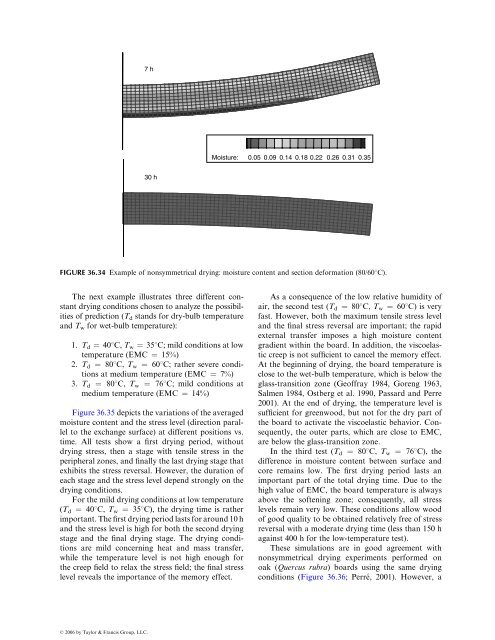36 Drying of Wood
36 Drying of Wood
36 Drying of Wood
- No tags were found...
Create successful ePaper yourself
Turn your PDF publications into a flip-book with our unique Google optimized e-Paper software.
7 hMoisture: 0.05 0.09 0.14 0.18 0.22 0.26 0.31 0.3530 hFIGURE <strong>36</strong>.34 Example <strong>of</strong> nonsymmetrical drying: moisture content and section deformation (80/608C).The next example illustrates three different constantdrying conditions chosen to analyze the possibilities<strong>of</strong> prediction (T d stands for dry-bulb temperatureand T w for wet-bulb temperature):1. T d ¼ 40 8C, T w ¼ 358C; mild conditions at lowtemperature (EMC ¼ 15%)2. T d ¼ 80 8C, T w ¼ 60 8C; rather severe conditionsat medium temperature (EMC ¼ 7%)3. T d ¼ 80 8C, T w ¼ 76 8C; mild conditions atmedium temperature (EMC ¼ 14%)Figure <strong>36</strong>.35 depicts the variations <strong>of</strong> the averagedmoisture content and the stress level (direction parallelto the exchange surface) at different positions vs.time. All tests show a first drying period, withoutdrying stress, then a stage with tensile stress in theperipheral zones, and finally the last drying stage thatexhibits the stress reversal. However, the duration <strong>of</strong>each stage and the stress level depend strongly on thedrying conditions.For the mild drying conditions at low temperature(T d ¼ 408C, T w ¼ 35 8C), the drying time is ratherimportant.Thefirstdryingperiodlastsforaround10hand the stress level is high for both the second dryingstage and the final drying stage. The drying conditionsare mild concerning heat and mass transfer,while the temperature level is not high enough forthe creep field to relax the stress field; the final stresslevel reveals the importance <strong>of</strong> the memory effect.As a consequence <strong>of</strong> the low relative humidity <strong>of</strong>air, the second test (T d ¼ 80 8C, T w ¼ 60 8C) is veryfast. However, both the maximum tensile stress leveland the final stress reversal are important; the rapidexternal transfer imposes a high moisture contentgradient within the board. In addition, the viscoelasticcreep is not sufficient to cancel the memory effect.At the beginning <strong>of</strong> drying, the board temperature isclose to the wet-bulb temperature, which is below theglass-transition zone (Ge<strong>of</strong>fray 1984, Goreng 1963,Salmen 1984, Ostberg et al. 1990, Passard and Perre2001). At the end <strong>of</strong> drying, the temperature level issufficient for greenwood, but not for the dry part <strong>of</strong>the board to activate the viscoelastic behavior. Consequently,the outer parts, which are close to EMC,are below the glass-transition zone.In the third test (T d ¼ 80 8C, T w ¼ 76 8C), thedifference in moisture content between surface andcore remains low. The first drying period lasts animportant part <strong>of</strong> the total drying time. Due to thehigh value <strong>of</strong> EMC, the board temperature is alwaysabove the s<strong>of</strong>tening zone; consequently, all stresslevels remain very low. These conditions allow wood<strong>of</strong> good quality to be obtained relatively free <strong>of</strong> stressreversal with a moderate drying time (less than 150 hagainst 400 h for the low-temperature test).These simulations are in good agreement withnonsymmetrical drying experiments performed onoak (Quercus rubra) boards using the same dryingconditions (Figure <strong>36</strong>.<strong>36</strong>; Perré , 2001). However, aß 2006 by Taylor & Francis Group, LLC.
















